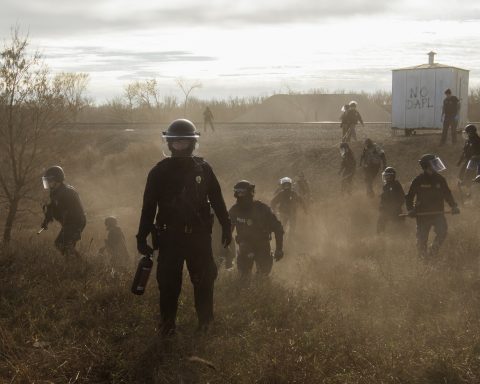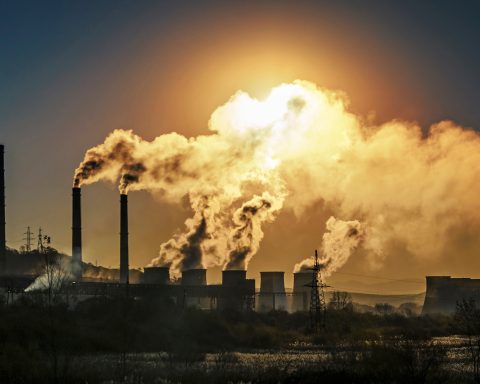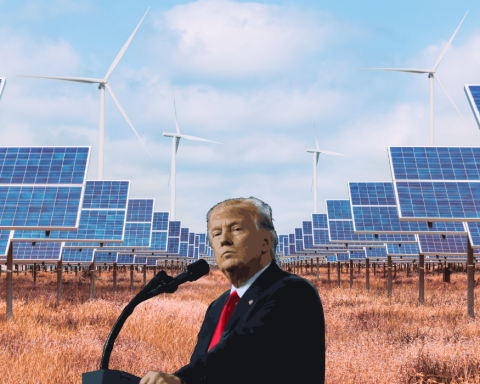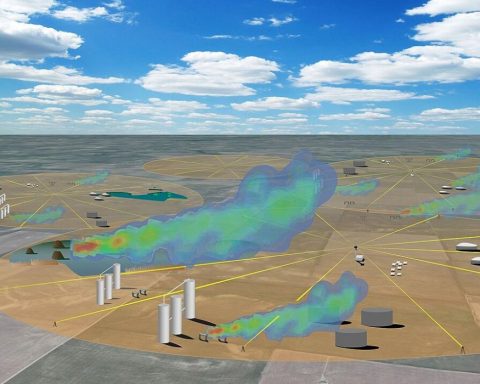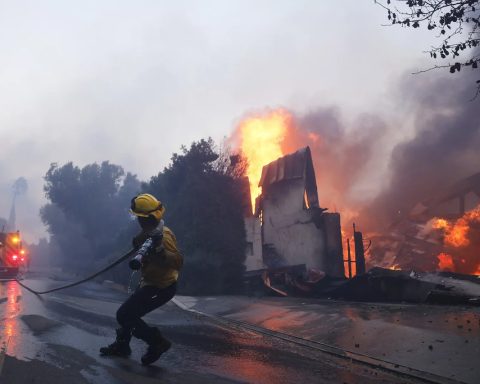From my 100-foot fire tower in northwestern Alberta, I gaze down at several people toiling away in a nearby cut block, their bodies bent forward, bags of seedlings tied to their waists, spades in hand, digging, slipping in a young tree and firming up the soil with a boot. They work quietly, steadfast under a hot sun.
They’re among the handful of people that I’ll come to meet over a summer of watching for smoke in the boreal forest: tree planters, responsible for regenerating forests – a vital carbon sink – across Canada.
“You always have a tree in your hand, you’re always ready; that’s one of the secrets of tree planting,” says Caitlin Burge, operations manager for Next Generation Reforestation, a company that’s been working in northern Alberta and British Columbia for 40 years, regenerating harvested and burnt forest plots for timber companies.
While advancements in technology have changed the way her company does business – using digital tools to survey and map sites, for one – the most effective way to plant a tree remains fundamentally the same today as it was 40 years ago. Dig, plant, cover, repeat. “It’s analog,” says Burge, who spent 14 years planting in Alberta and B.C. “It becomes a moving meditation.”
On average, Canada’s 6,500 tree planters sow around 2,300 seedlings a day and up to 184,000 in a season. Tree planting and reforestation can play a vital role in Canada’s effort to balance carbon emissions. And increasingly, it is seen as a global solution to the climate crisis through efforts such as the World Economic Forum’s “one trillion tree” initiative. In Canada, the federal government has pledged to increase the 600 million seedlings it plants every year by 30% – investing more than $3.2 billion to plant two billion trees by 2031.
But in the wake of the worst wildfire season on record in Canada, it isn’t as simple as just planting more trees, climate scientists say. In fact, what we’ve been planting and how we’ve been managing our forestry stock have urgent lessons for us to heed. With wildfires igniting a record-breaking 18.5 million hectares of forest – unleashing unprecedented carbon emissions – experts argue that it’s time to take a closer look at tree planting in Canada, planning for the challenges ahead while also contemplating opportunities for change.
In early May, Krishandra Zimmer and Lawrence Fraser were setting up camp outside the town of High Prairie, Alberta, when a wildfire raged furiously across the highway, threatening to shut down their operations before the first tree seedling was even in the ground.
As project managers with Next Generation Reforestation, they are contracted by logging companies to survey and replant harvested cut blocks. They’re on the front lines of Canada’s $34.8-billion forestry sector, and they’re watching it go up in smoke.
“There were fires burning everywhere,” Fraser says. “We decided the best thing to do was to get everybody here in one place.”
Zimmer and Fraser’s crew of 50 tree planters scrambled to find their way north to the camp, encountering highway and road closures due to other wildfires burning out of control in Alberta. Most of the planters were from eastern Canada, unfamiliar with the network of remote logging roads. Some had come with work visas from as far away as Ireland, Australia and Colombia.
The veteran tree planters have been planting spruce and pine seedlings in cut blocks and old burns scattered across northwestern Alberta since 1994. They’ve seen bolts of lightning strike trees and ignite wildfires, and they routinely report smoke columns to provincial firefighting agencies. “We’ve dealt with fire and smoke before,” Zimmer says. “But this season has been unprecedented. We’ve never been surrounded by so many wildfires.”
“It was an onslaught,” Fraser agrees.
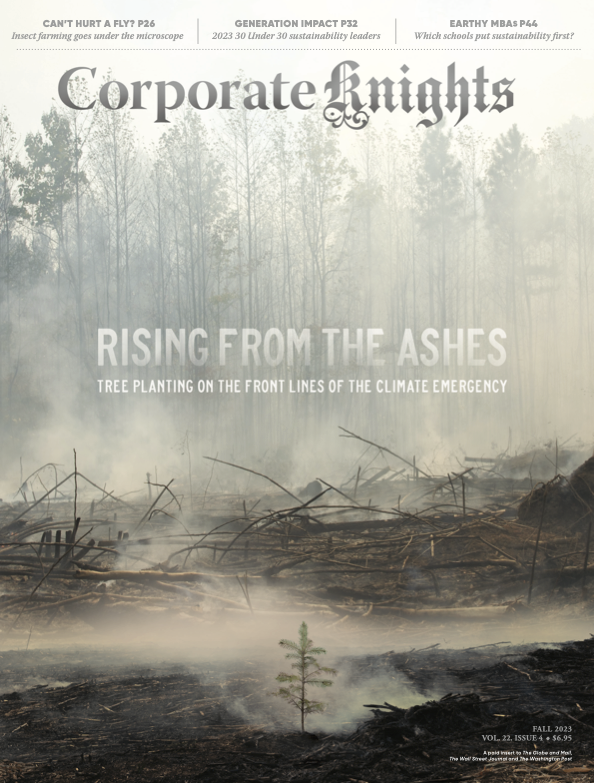
The severity of the wildfires created enormous logistical and environmental challenges for Zimmer and Fraser’s crew to meet their planting targets. They were constantly checking fire status and wind direction to reassess where they could safely plant. One of the biggest challenges was enduring the physical stress of planting trees while inhaling heavy smoke from the nearby wildfires. “Some days we just couldn’t work – it wasn’t safe,” Zimmer says.
Nothing was as devastating as witnessing the scorched aftermath in areas where they’d planted trees over the last three decades. “Millions and millions of replanted trees lost,” Fraser says.
“Last fall we surveyed some of the blocks we planted 12 years ago. There was this one area that was doing so well – we were so happy,” Zimmer says. “Now that area has been burnt to a crisp. It’s absolutely heartbreaking.”
As a result of the burgeoning wildfire crisis, Canada is facing enormous challenges when it comes to reforestation and balancing carbon emissions. According to research from the Canadian Forest Service, the country’s managed forests have transitioned from being a carbon sink in the 1990s to a rapidly expanding source of carbon emissions.
Last fall we surveyed some of the blocks we planted 12 years ago. There was this one area that was doing so well. Now that area has been burnt to a crisp. It’s absolutely heartbreaking.
—Krishandra Zimmer, Next Generation Reforestation
“When trees grow, they remove carbon dioxide from the atmosphere and store it as carbon compounds in the branches and leaves,” explains Werner Kurz, a senior research scientist with the Canadian Forest Service. “When a wildfire comes, it directly releases much of that carbon and greenhouse gases back into the atmosphere,” he says. “And it kills a large number of trees.”
The dead trees, often left scorched and standing, gradually decompose and release additional carbon dioxide, which scientists measure as an indirect emission. Kurz’s colleague Benjamin Hudson calls the preliminary volume of direct carbon emissions from the total area burned in the 2023 wildfire season “staggering.”
“We’re getting up in the range of about 1,800 million tonnes of carbon dioxide equivalents that we’ve emitted to date from wildfires in 2023 alone,” he says. To put that in context, that’s triple the total emissions from all industrial sectors in Canada combined – including transportation, oil and gas, and manufacturing – as reported in the National Inventory Report in 2021.
Megafires like the Donnie Creek fire in northeastern B.C., which as of early September was over half a million hectares in size and the largest wildfire in the province’s history, are responsible for releasing millions of tonnes of carbon into the atmosphere. These large-scale wildfires also have the potential to burn deep into the soil, destroying the organic layer, which provides nutrients to seedlings and acts like a sponge to prevent runoff. “This is another phenomenon of wildfires,” Kurz says. “Basically, the soil surface becomes hydrophobic, which can lead to flooding.”
Megan Babineau, a forester who works for a mill operation in Alberta, witnessed this phenomenon after a megafire swept through the forest surrounding Edson, northwest of Calgary, where she was supposed to plant in the spring. In June, the rains finally came – and didn’t stop. “It was crazy to go from fire to this extreme rain event,” she says. “So much rain fell in one shot, and it didn’t have anywhere to go quickly enough.”
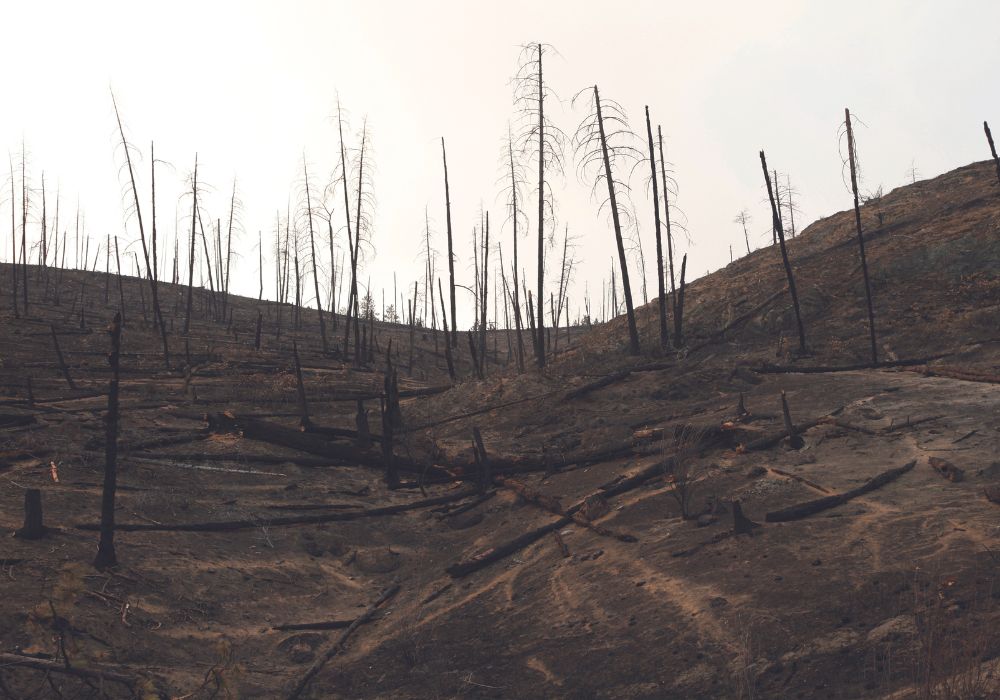
A lake formed in the burned-over area where they were meant to plant and risked completely drowning out the seedlings. “The actual biology of these places is totally changed,” Babineau says.
Compounding matters for Babineau and tree-planting operations across the continent is an ongoing shortage of tree seedlings that was worsening long before this year’s fires. With the sheer scale of charred forests that will need to be replanted next year, in addition to the quota that had already been set, nurseries are struggling to keep up.
“It’s not just one mill; it’s everybody in Canada who needs burnt cut blocks to be replanted,” Fraser says. “The burnt areas just create new volume, and there’s only so much capacity in the nurseries. It’s going to be a challenge.”
In the race to regenerate forests in Canada, seed-spreading drones, wildfire-monitoring satellites and genetically engineered trees are being experimented with. But climate scientists say that it’s critical to hit pause and reassess the legacy of practices in forest management that have made “significant contributions” to the devastating scale of wildfires threatening communities today. “By focusing on timber production, we have inadvertently made choices that have impacts on wildfire behaviour,” Kurz says.
Robert Gray, a wildfire ecologist who has studied wildfire on the boreal landscape for more than 40 years, agrees that we’ve set ourselves up for wildfire disaster. Over the last century, Canada has allowed timber companies to log, or clear-cut, forests and replant monoculture plantations of coniferous softwoods, including lodgepole pine and spruce. These coniferous trees are considered highly flammable: they thrive in wildfires, relying on the heat from the flames to open their cones and release seeds to reproduce.
In a naturally biodiverse forest ecosystem, certain trees will slow down the spread of wildfires, including deciduous species such as poplar and birch. But the timber industry relies heavily on the use of glyphosate, a herbicide, to kill broad-leafed trees, clearing space for more commercially valuable conifers. Despite calls to ban the practice, it’s still commonplace across Canada.
Monocrop conifer plantations have also led to disastrous epidemics in Canada’s boreal forest, including the mountain pine beetle outbreak, which, since the early 1990s, has killed more than 18 million hectares of forest in Western Canada. Gray’s research has found that forests ravaged by the beetles exhibit extreme fire behaviour, which has, in turn, contributed to the acceleration of megafires, including the Donnie Creek fire. “If we don’t step out of that mode of replanting conifers, we aren’t going to solve anything,” Gray says.
Gray and other climate scientists are advocating for policy change in the way forests are regenerated, planting instead more broad-leafed deciduous and hardwood species, which reduce flammability and help to slow the spread of wildfires.
Non-profit organizations such as Community Forests International (CFI), a reforestation organization based in Sackville, New Brunswick, are already ahead of industry in terms of planting more climate-adapted species, including red oak, maple and yellow birch. CFI is partnered with Canada’s 2 Billion Trees program to plant 951,000 trees in Atlantic Canada over the next three years.
In addition to planting with wildfire resilience in mind, CFI and other advocates say that we must protect old-growth forest and primary forest (forests that have never been logged), vital carbon sinks, from being cut down in the first place. In B.C., old-growth forest covers 12% of the province. While companies still harvest 38,000 hectares of old-growth forest every year, the province claims that the rate is sharply declining.
“We have to protect forests that are functioning ecosystems today, as well as work towards the recovery and restoration of those natural processes on degraded sites,” says Craig Tupper, a former wildland firefighter in Nova Scotia who is now a forester with CFI.

His colleague Michelle Evans, also a CFI forester, points out that tree planting is not the only way to regenerate healthy forests in Canada. “Tree planting will never be able to keep up with industrial harvesting – the way it currently is,” she says. In fact, the opposite – thinning and reducing forests – might be more beneficial in the long run. Rather than clear-cutting an area with heavy-duty equipment, Evans is working with small ground crews to harvest more frequently but at a lower rate.
Werner Kurz with the Canadian Forest Service agrees that one of the best things we can do to balance carbon emissions – while mitigating the risk of extreme wildfire – in Canada is to strive to reduce fuels – dead trees that feed fires – from forests. Thinning in the name of fire protection has been criticized by some fire ecologists as simply “logging in disguise.” But thinning doesn’t mean giving the logging industry a free pass to harvest wherever they please, Kurz says; rather, we should have a design approach in mind and target areas where there’s a higher incidence of lightning on the landscape.
A combination approach of planting more broad-leafed and hardwood tree species in some areas and thinning forests in other areas could make Canada’s forests more fire-resistant.
But mechanical thinning is costly, Kurz admits, and that’s why Canadians will need to learn how to live more closely with what he and other fire ecologists call “good fire.”
Cultural burning, or prescribed burning, is a management tool used to reduce the amount of fuel in the landscape. Historically, First Nations people lit fires during the early spring or late fall, when conditions were cool and wet, to burn off fine fuels (leaf litter, sticks, branches and dried needles) to regenerate forest into meadows for berry production and to encourage ungulates, such as moose and elk, back into an area. The practice was outlawed by the B.C. government in 1874, but Joe Gilchrist, an Indigenous fire specialist with the Salish Fire Keepers Society, is working to bring it back. He partners with communities to burn between 500 and 1,000 hectares in B.C.’s interior every spring.
“All of the work done by the ancestors has gone, and now we have forests that are unhealthy and overgrown,” Gilchrist says. “That’s what we’re seeing now with these catastrophic fires, which never should be happening.”
Gray agrees. He works closely with First Nations communities in southeastern B.C. to practise cultural and prescribed burns to mitigate the threat from wildfires. “Prescribed burning is so key,” he says. “It cleans up the fuel particle size, the stuff we can’t get at while harvesting.”
All the work done by the ancestors is gone, and now we have forests that are unhealthy
and overgrown.
—Joe Gilchrist, Indigenous fire specialist, Salish Fire Keepers Society
Gray points to research from Oregon State University that recently determined that embers, small bits of burning material that can be carried by the wind to spread wildfires, aren’t from the big logs or huge burning trees, but rather from smaller material like sticks and branches. As a result, prescribed burning can help to reduce the spread of wildfires by cleaning up smaller fuels.
In July, one of the plots on the ?aq'am Reserve in southeastern B.C. where Gray and the Ktunaxa First Nation implemented a prescribed burn was tested when a nearby wildfire broke out. “The wildfire slammed into the area of the prescribed burn,” Gray says. “It stopped because there was no fuel to carry it. Unfortunately, where we hadn’t done the prescribed burn, it got into the village and destroyed seven homes. So it does work to slow down fires.”
Solutions to the current climate crisis in Canada – including burgeoning wildfires, increasing greenhouse gas emissions and the failure to keep pace with replanting forests – need to be implemented on a scale that’s “almost overwhelming,” Kurz says.
What’s required is political will, scientists say, to guide the direction of industry, along with public understanding that the way we manage forests has to change.
Trina Moyles is a Yukon-based writer and the author of Lookout: Love, Solitude, and Searching for Wildfire in the Boreal Forest.


